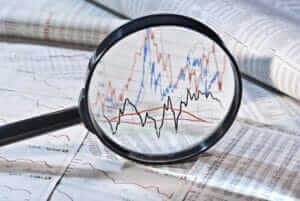Professionals who see volume as a prerequisite of success view any lack of volume as an important factor. Traders need volume to know if the trade they are interested in is worth taking. They explain how volume directly affects the chart because it is what moves the market. As volume is changeable – both in the sense of the entire forex market and particular currency pairs – we wonder where this volume inconsistency stems from.
 Having left the gold standard in the 1960s, most currencies across the globe are no longer backed up by equivalent amounts of hard assets. This left much room for the governments and banks to manipulate the circulation of currencies, increasing the overall money supply. As more money is printed, consumers demand more goods, which results in increased prices. The overall volume of money in the market does not only refer to the cash that circulates in the economy, but the digital money as well (bank accounts), and any changes will have an impact on both. Forceful printing can have terrible consequences like what happened to Zimbabwe, which kept printing more money to the point of its official currency becoming entirely worthless. As money moves, so does the volume we see in the market. For example, in 2019, many noticed how the stock market experienced a long period of prosperity, supported by unprecedented growth levels. As all money flooded into stocks, the market’s expansion triggered historic lows in the spot forex. Such dynamics between the two markets depend on the concentration of money that fluctuates alternately. Volume is affected by other factors as well, such as market condition and geopolitical status, and news.
Having left the gold standard in the 1960s, most currencies across the globe are no longer backed up by equivalent amounts of hard assets. This left much room for the governments and banks to manipulate the circulation of currencies, increasing the overall money supply. As more money is printed, consumers demand more goods, which results in increased prices. The overall volume of money in the market does not only refer to the cash that circulates in the economy, but the digital money as well (bank accounts), and any changes will have an impact on both. Forceful printing can have terrible consequences like what happened to Zimbabwe, which kept printing more money to the point of its official currency becoming entirely worthless. As money moves, so does the volume we see in the market. For example, in 2019, many noticed how the stock market experienced a long period of prosperity, supported by unprecedented growth levels. As all money flooded into stocks, the market’s expansion triggered historic lows in the spot forex. Such dynamics between the two markets depend on the concentration of money that fluctuates alternately. Volume is affected by other factors as well, such as market condition and geopolitical status, and news.
 Market volume always changes and, sometimes, the volume can be really low for a longer period of time. When this happens there are a few important rules to remember:
Market volume always changes and, sometimes, the volume can be really low for a longer period of time. When this happens there are a few important rules to remember:
- Dead markets are normal and happen regardless of your skills and knowledge.
- Do not push yourself to enter any trades if you are not getting any signals.
- If you are testing your system now, you may not get much yield because of the state of the market.
- If you are getting signals to trade, steer clear of the USD (especially if you are a beginner). When the market is sluggish or dead, the big banks will thrive off the USD where most traders are.
- Take the entire trade-off at your first take profit.
- Because the volume will return at one point, your volume indicator may not be quick enough to notice the change, so you may miss the first big move.
- Trade smaller time frames to get quicker results in this period.
- Prepare yourself for fluctuation volume now and do not expect tailwinds all the time.
 Volume indicators are believed to be one of the most important constituents of professional traders’ algorithms. Not only do they increase the chance of winning in each trade but they also serve to prevent losses, which is a prerequisite for sustainable success. However, it is important to distinguish between volume and volatility. While we do need volume in the market, we should look for the most volatile or liquid pairs. Indicators such as the ATR are excellent tools for measuring volatility in the market and calculating the risk. The Cboe EuroCurrency Volatility Index also tracks the short-term projected volatility of the EUR/USD exchange rate. While any volatility information can prevent the trader from making the wrong choices, volatility indicators should be used together with a volume indicator to achieve the best results.
Volume indicators are believed to be one of the most important constituents of professional traders’ algorithms. Not only do they increase the chance of winning in each trade but they also serve to prevent losses, which is a prerequisite for sustainable success. However, it is important to distinguish between volume and volatility. While we do need volume in the market, we should look for the most volatile or liquid pairs. Indicators such as the ATR are excellent tools for measuring volatility in the market and calculating the risk. The Cboe EuroCurrency Volatility Index also tracks the short-term projected volatility of the EUR/USD exchange rate. While any volatility information can prevent the trader from making the wrong choices, volatility indicators should be used together with a volume indicator to achieve the best results.
 The DOM indicator is one of the popular volume indicators in the forex community with an impressive Google search frequency. Based on the brokers’ data, this indicator offers an insight into the price levels with the heaviest volume. Traders often seem impressed with the DOM’s performance, but fail to understand that any dealing desk broker’s information is limited to levels and does not stand for the overall volume. Therefore, this indicator simply cannot help us understand volume or how the market is going to respond. What it can do, however, is hinder our development because everyone can access this information easily. The DOM is easily available on the most popular trading platforms and, due to its popularity, most traders like to use it. Yet the DOM lacks information that we could use for trading consistently. The order concentration levels it represents are not going to be the guiding light for your forex trading. Other assets like crypto have more reliable data from the exchanges about these levels, BTC is a good example with so many positions stacked around the $20k price level.
The DOM indicator is one of the popular volume indicators in the forex community with an impressive Google search frequency. Based on the brokers’ data, this indicator offers an insight into the price levels with the heaviest volume. Traders often seem impressed with the DOM’s performance, but fail to understand that any dealing desk broker’s information is limited to levels and does not stand for the overall volume. Therefore, this indicator simply cannot help us understand volume or how the market is going to respond. What it can do, however, is hinder our development because everyone can access this information easily. The DOM is easily available on the most popular trading platforms and, due to its popularity, most traders like to use it. Yet the DOM lacks information that we could use for trading consistently. The order concentration levels it represents are not going to be the guiding light for your forex trading. Other assets like crypto have more reliable data from the exchanges about these levels, BTC is a good example with so many positions stacked around the $20k price level.
 Volume indicators are key money management and risk management tools, but many of them offer similar information. Therefore, to understand any given data concerning volume, traders need to learn how to read the numbers which they are presented with. So, if any indicator reveals a price that is several pips higher, traders need to be cautious because the information they see is incomplete. We still do not know anything about the type of orders that comprise this volume, whether they are limit or stop orders, or if the majority is entering long or short trades at the time. Traders should also be invested in discovering the predominant percentage of long and short trades because it will help them determine the correlation between volume and the types of trades forex traders are typically entering at the time. The missing information is crucial for understanding volume in the forex market, as numbers alone have no meaning. We still lack the qualitative analysis of the market to understand what is happening.
Volume indicators are key money management and risk management tools, but many of them offer similar information. Therefore, to understand any given data concerning volume, traders need to learn how to read the numbers which they are presented with. So, if any indicator reveals a price that is several pips higher, traders need to be cautious because the information they see is incomplete. We still do not know anything about the type of orders that comprise this volume, whether they are limit or stop orders, or if the majority is entering long or short trades at the time. Traders should also be invested in discovering the predominant percentage of long and short trades because it will help them determine the correlation between volume and the types of trades forex traders are typically entering at the time. The missing information is crucial for understanding volume in the forex market, as numbers alone have no meaning. We still lack the qualitative analysis of the market to understand what is happening.
 Volume will always oscillate and there is not much we can do to change that. What we can do, however, is approach it in a smart way. Your approach to trading is vital for your overall success, so if you are not prepared mentally or emotionally, your account will suffer no matter the conditions. Traders often think that the higher the volume, the better, but dead markets can also be an excellent opportunity for growth. If we succumb to the challenges and fail to apply money management skills now, we won’t be able to reap the fruits later. What you can always do to improve yourself is to focus your attention on your trading skills and system. Is there anything you can change? How can you improve your algorithm to function even better? Remember to stay on the course and power through by doing what you can and what is best for your trading account. When there are no opportunities for making money, there is abundant room for backtesting and forward testing your algorithm. If you have a strong vision, use the times with no volume to reflect on the lessons and the choices you made in the past. Even if you had big plans to quit your job in a year and devote yourself exclusively to trading currencies, now is not the time to make such changes. Keep your other sources of income and use the time you have wisely, perfecting your system for future success.
Volume will always oscillate and there is not much we can do to change that. What we can do, however, is approach it in a smart way. Your approach to trading is vital for your overall success, so if you are not prepared mentally or emotionally, your account will suffer no matter the conditions. Traders often think that the higher the volume, the better, but dead markets can also be an excellent opportunity for growth. If we succumb to the challenges and fail to apply money management skills now, we won’t be able to reap the fruits later. What you can always do to improve yourself is to focus your attention on your trading skills and system. Is there anything you can change? How can you improve your algorithm to function even better? Remember to stay on the course and power through by doing what you can and what is best for your trading account. When there are no opportunities for making money, there is abundant room for backtesting and forward testing your algorithm. If you have a strong vision, use the times with no volume to reflect on the lessons and the choices you made in the past. Even if you had big plans to quit your job in a year and devote yourself exclusively to trading currencies, now is not the time to make such changes. Keep your other sources of income and use the time you have wisely, perfecting your system for future success.
We may be looking for different tools and methods to obtain volume data, but the focal point of this article is that our attention should be elsewhere. We cannot predict the future and we certainly cannot find one indicator that will do all the work on our behalf. Rather, we should become skillful in combining different indicators to eliminate bad trades, reduce losses, and earn smart money. And, finally, we must bear in mind that times of no volume and no income are also fruitful periods for any individual to become a better and more prosperous trader.





